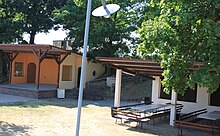Weir grove
Wehrhain is a district of the city of Schlieben in Brandenburg . The place has about 260 inhabitants on an area of 817 hectares. It is located about two kilometers east of the core city.
history
Until January 1, 1938, the place was called Werchluga , which was replaced by the freely invented name "Wehrhain" as part of the National Socialist Germanization of Sorbian place names. The name Werchluga can be interpreted as a place on the swamp .
In 1525, 780 willows were planted, and in 1533 another 90. Presumably there was an abundance of fruit growing. Oak and birch secured the need for wood. There was a mill in the village and a forge. The place did not have its own cemetery. There was a prayer house in the village that was used as a school from 1800. One of the first teachers was a shoemaker by trade. He practiced his trade during class and used the knee strap to chastise students. In the years after the Second World War , the school had to close several times due to epidemics, a lack of fuel for heating and structural defects. In 1946, the future writer Werner Heiduczek worked as a new teacher in Wehrhain.
The farmers lived, among other things, from growing hops and cutting peat .
On November 1, 2001, Wehrhain was incorporated into Schlieben.
Mill history
A water mill and a windmill are mentioned for 1820. In 1850 a miller is called Lehmann, in 1906 only one mill can be seen on the measuring table. The last mill, a very rare Erdholländermühle , belonged to Hugo Türk in 1926/18. His descendants operated the mill until the 1970s. Since the 1980s, the wingless mill had been left to decay. Rescue attempts were unsuccessful. The owners had finally applied for demolition.
On the night of December 31, 2010 to January 1, 2011, the landmark of Wehrhain, the old mill, was destroyed by a fire around 1:15 a.m.
- The former Wehrhainer Erdholländer windmill.
Culture and sights
The building at Lindenstrasse 13 is entered in the local list of monuments. It can be found on the northeast side of the Angers. It is a 1 1 ⁄ 2- story brick building with a gable roof.
Furthermore, in a war memorial is for those in the First World War to find fallen and missing villagers. The monument consists of a stele on a three-tiered base . The names of the fallen are inscribed on the sides. On two other sides of the memorial there are the inscriptions: "Death for the fatherland is worth eternal veneration." And "Those who remained in the World War - Erected in 1921" .
The motorcycle regulars table has traditionally been inviting since 1991 on the second weekend in July to the largest festival in Wehrhain, the motorcycle meeting, on the sports field, the hole . An open-air stage, a bar, a dance floor, a bowling alley and sanitary facilities have enabled successful events in the hole for several years . The soccer tournament organized by the village youth every September takes place there.
In February, mostly young residents come together in traditional costumes to pound through the village and collect all kinds of food, drink and money.
economy
Several medium-sized craft and service companies are based in the village.
literature
Sybille Gramlich, Irmelin Küttner: Elbe-Elster district part 1: The city of Herzberg / Elster and the offices of Falkenberg / Uebigau, Herzberg, Schlieben and Schönewalde. ISBN 978-3-88462152-3
Web links
Notes and individual references
- ^ Hans-Dieter Lehmann: Pictures from the Schliebener official area. In: Schliebener Official News , March 17, 1995.
- ↑ StBA: Changes in the municipalities in Germany, see 2001
- ↑ Sven Gückel: Wehrhain: This time the mill loses the battle. In: Lausitzer Rundschau . October 6, 2006, accessed July 10, 2016 .
- ↑ Birgit Rudow: The fate of the Wehrhainer mill not yet sealed? In: Lausitzer Rundschau . October 25, 2006, accessed July 10, 2016 .
- ↑ The Wehrhainer property at Lindenstrasse 13 in the database of the Brandenburg State Office for Monument Preservation and State Archaeological Museum , accessed on December 4, 2016.
- ↑ Sybille Gramlich, Irmelin Küttner: Elbe-Elster district, part 1: The city of Herzberg / Elster and the offices of Falkenberg / Uebigau, Herzberg, Schlieben and Schönewalde. ISBN 978-3-88462152-3 , p. 349
- ↑ Contribution by Reinhard Naumann (2005) to the online project Gefallenenkkmäler , accessed on December 4, 2017
Coordinates: 51 ° 43 ' N , 13 ° 25' E





